Native name Metro de Santiago Annual ridership 648.7 million (2012) Operator(s) Metro S.A. Began operation September 15, 1975 Number of stations 108 Transit type Rapid transit | Daily ridership 2.4 million Website Metro de Santiago System length 103 km (64 mi) Locale Santiago Number of lines 5 | |
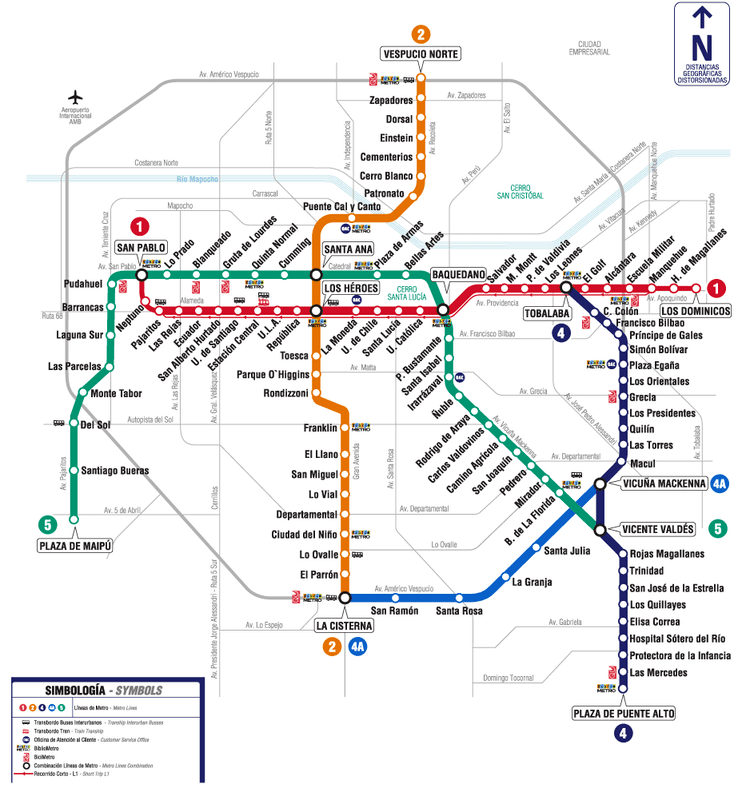 | ||
Santiago metro
The Santiago Metro (Spanish: Metro de Santiago) is the underground railway network serving the city of Santiago, Chile. This network is one of the most modern in Latin America, being the second largest following the Mexico City Metro, and it is 7th in frequency worldwide. It currently has five lines, 108 stations, and 103 kilometres (64.0 mi) of revenue route. This service is administered by the state-owned Metro S.A. and is the first of three urban railway systems in Chile, along with the Biotrén of Concepción (1999) and Merval of Valparaíso (2005).
Contents
- Santiago metro
- Early
- Project changes
- New lines and line extensions
- Rolling stock
- Stations
- Art in the Metro
- Station amenities
- Security and Safety
- Pricing and working hours
- References
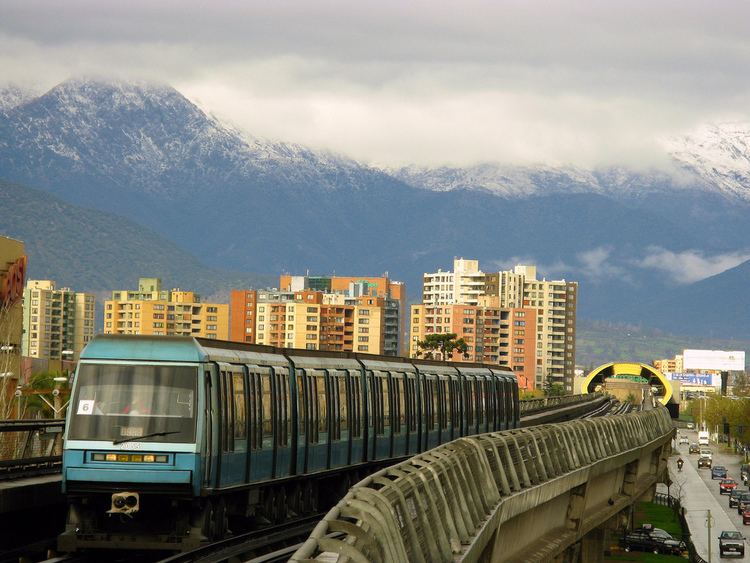
The Santiago Metro carries around 2.5 million passengers every day. This figure represents an increase of more than a million passengers per day compared to figures prior to 2007, when the ambitious Transantiago project was launched, in which the metro plays an important role in the public transport system serving the city. Its highest passenger peak was reached on 31 October 2012, reaching 2,780,666 passengers.

Along with its five operational lines, two new lines are being built – Line 6, connecting Cerrillos with Providencia with 11 new stations and an extension of 15.3 kilometres was announced in late 2009 and ratified in 2011, while the long delayed Line 3 will connect Huechuraba and La Reina with an extension of 21.7 kilometres and 19 new stations. Investment for the construction of these extensions is of nearly US$2.7bn and is expected to reach 120 million annual trips. In 2014, it was announced that Line 3 would be expanded even further towards the northwest, reaching Quilicura, and Line 2 would be expanded further south towards El Bosque and San Bernardo, adding 7 new stations to the network and an additional 8.8 kilometres of tracks by 2020. It was also announced that analytical studies would begin for the construction of a new line, Line 7 to cross the city from east to west to relieve congestion on Line 1.
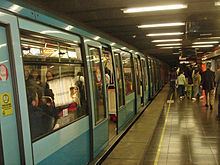
In March 2012, the Santiago Metro was chosen as the best underground system in the Americas, after being honoured at the annual reception held by Metro Rail in London.
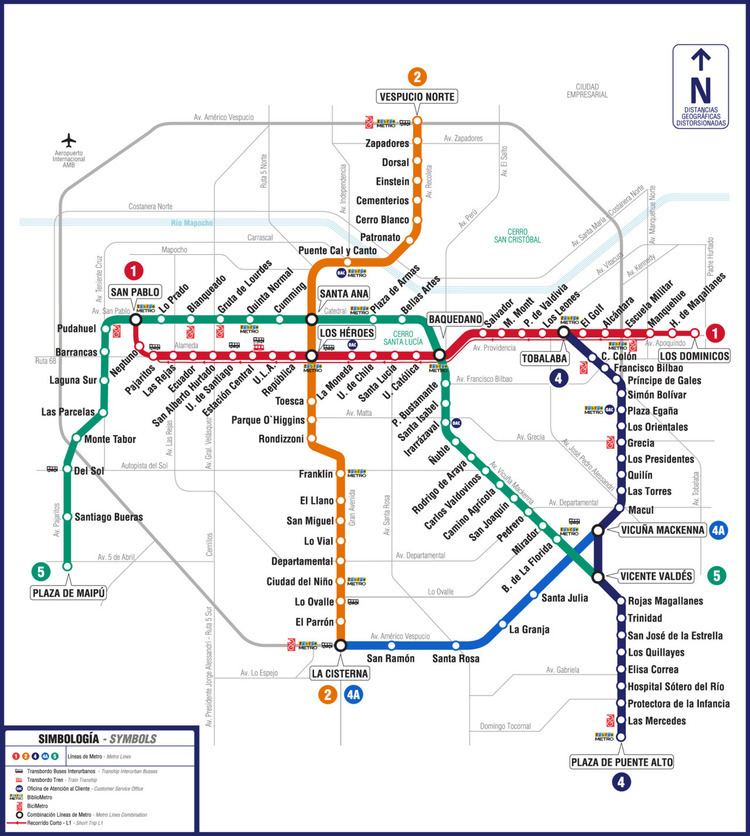
Early
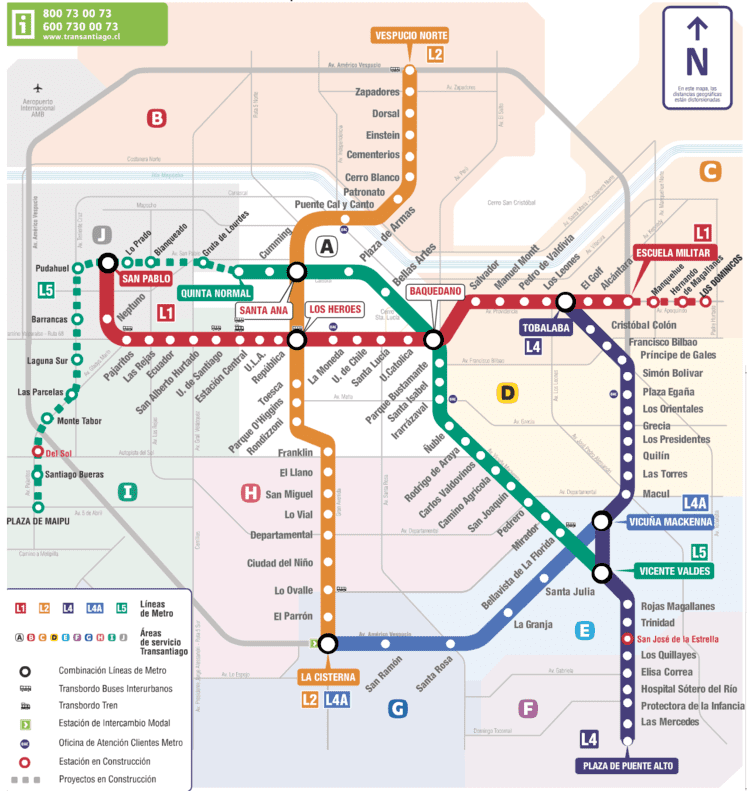
The idea to build an underground railway network in Santiago dates back to 1944, when new ways to improve the chaotic transport system were sought after the rapid population growth the city was experiencing since the early 1930s. However, ideas would begin to take shape in the 1960s, when the government released an international tender for the development of an urban transport system. On 24 October 1968, the government of Eduardo Frei Montalva approved the draft submitted by the Franco-Chilean consortium BCEOM SOFRETU CADE, in which the construction of five lines with an extension of approximately 60 kilometres by 1990 was proposed. On 29 May 1969, works finally began for the construction of the first line, which would link the Civil District and the area of Barrancas (current-day Lo Prado).
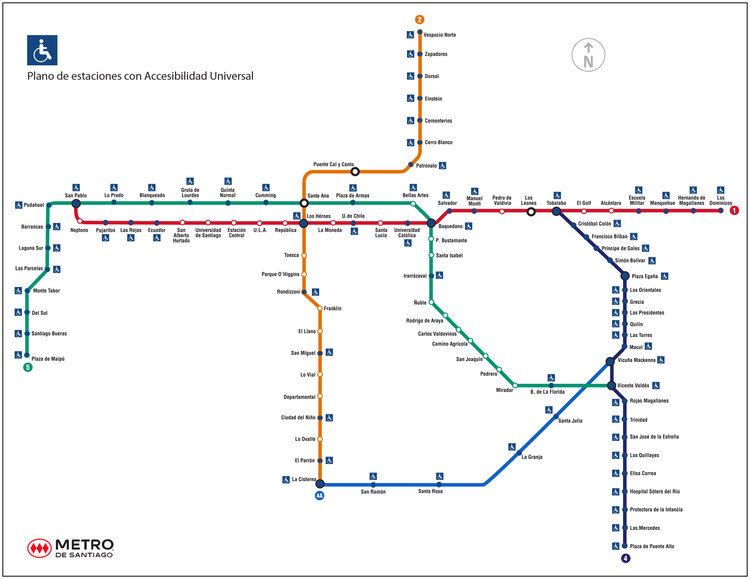
On 15 September 1975, the first line of the metro was opened by Augusto Pinochet during the military regime. Line 1, during its opening stage, was mostly underground from San Pablo to La Moneda, running below the Alameda. In 1977, the line was extended towards Providencia and by 1980, the line reached as far as Escuela Militar.
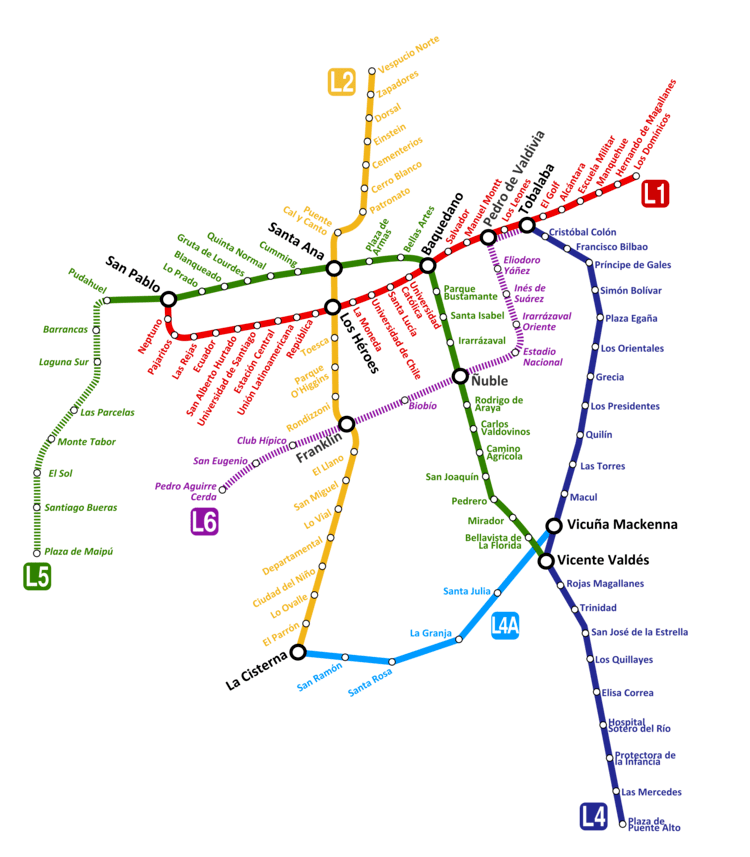
In March 1978, Line 2 was opened. Its initial section ran at ground level from Los Héroes to Franklin. By December, the second segment of the line was opened, running underground towards the south along the Gran Avenida up to Lo Ovalle.
Project changes

Despite the fast growth of the network, the severe economic crisis that affected the country in 1982 halted the original plans. Furthermore, studies showed that southeast Santiago was becoming more populated than the north end of the capital, area that was then covered by the planned extensions of the service.
In order to supply future demand, the layout for Line 2 was changed and the extension would start at Los Héroes and go around the Civic District, crossing Line 1 again at Baquedano to head south through Vicuña Mackenna. Meanwhile, Line 3 was projected through Independencia and Irarrázaval to supply the northern area that Line 2 was supposed to run.
However, these plans were affected once again when an earthquake struck the Chilean Central Valley on 3 March 1985. Most of the funds destined for the construction of the Line 2 extension and Line 3 were used to rebuild the city. The opening of two new stations towards the north in 1987 were the only finalised works from these plans: Santa Ana and Mapocho stations on Line 2. The latter would change its name later, as remains of the old Calicanto Bridge –emblem of the city for over a century– were discovered during the excavation process. That same year, the Metrobús service was launched with services operating from Escuela Militar, Lo Ovalle and Las Rejas.
Institutionally, the management of Metro de Santiago was changed at the end of the decade. The former General Directorate of Metro, a branch of the Ministry of Public Works, became a state-funded public company, Metro S.A., with the provisions of Law 18,772 published on 28 January 1989.
Following the economic recovery after the second miracle, the metro's expansion plans resurged. Population growth in the southeastern area of the capital became unstoppable during the 1980s, and La Florida became the most populous commune in the country, thus the construction of a new line to supply that area was paramount. The first plans were drawn in 1989 and it was officially announced in 1991 by President Patricio Aylwin. This new line would start from Baquedano and head southwards to Américo Vespucio Avenue, crossing through Vicuña Mackenna.
Line 5 was opened on 5 April 1997 by President Eduardo Frei Ruiz-Tagle. This new line would have a length of 10.3 kilometres initially running underground from Baquedano to Irarrázaval, emerging as a viaduct on Vicuña Mackenna and going underground before reaching its southeastern terminus, Bellavista de la Florida.
Finally, in March 2000, a new section of Line 5 crossing the historic centre of the capital was opened to the public. The new connection between Baquedano and Santa Ana through Plaza de Armas and Bellas Artes meant that all three existing lines would be connected.
New lines and line extensions
With the election of Ricardo Lagos as President of Chile in 2000, one of his main objectives was an overhaul of the transport system serving the capital. To achieve this, a new extension for Line 5 was designed, heading westwards to Quinta Normal, following Catedral street, and an extension for Line 2 from both ends of the line to reach the northern and southern ends of the Américo Vespucio ring road.
Despite this, the biggest announcement was made in 2002 when Lagos disclosed the construction of a fourth line for the metro, serving the southeastern communes of Santiago to reach the heart of Puente Alto, which had taken over La Florida as the most populous commune of the country. With these new projects, the Metro network would double its extension by 2010, year in which the country would celebrate its bicentennial.
These new projects were designed to make Metro the key element of the new transport reform plan for the city, Transantiago. Along with the new extensions, exchange stations were designed to allow for a better interaction between the urban railways and other means of transport, mainly buses. The first exchange station would open in Quinta Normal after the Line 5 extension was finalised on 31 March 2004. However, the original plan to host a railway station would be discarded following the failure of the Melitrén construction.
On 8 September 2004, the Metro would make another breakthrough when the Mapocho river was crossed underground, with the opening of Patronato and Cerro Blanco stations on Line 2. On 22 December 2004, the southern extension of the same line opened its new stations, El Parrón and La Cisterna. A second stretch of Line 2 towards the north would open on 25 November 2005, and the last in the series of extensions opened on 22 December 2005, with a total cost of US$170 million and a 27-million passenger increase annually.
On 30 November 2005, the first underground leg of Line 4 from Tobalaba to Grecia, and the viaduct between Vicente Valdés and Plaza de Puente Alto opened to the public. The unfinished track from Grecia and Vicente Valdés was covered by a rail replacement bus service operated by Transantiago until 2 March 2006, when the remaining stations and track were finished. Line 4 at this time was the longest of the network, with an extension of 24.7 kilometres and 22 stations serving Providencia, Las Condes, Ñuñoa, La Reina, Peñalolén, Macul, La Florida and Puente Alto. This new line also saw the introduction of new rolling stock, the AS-2002, manufactured by Alstom in Brazil, featuring more interior space than those running other lines. Finally, Line 4 would be complemented with the opening of a branch service on 16 August 2006, Line 4A, which connected Line 2 from La Cisterna with Line 4 at Vicuña Mackenna, running through the Américo Vespucio ring road.
Rolling stock
The Santiago Metro currently operate 7 models of rolling stock: one model (the AS 2002) is steel-wheeled, while the others are all rubber-tyred. The NS 74 and NS 93 stock are based on the MP 73 and MP 89 stock of the Paris Metro respectively, while the NS 2007 stock is based off the NM-02 stock of the Mexico City Metro. All rubber-tyred stock are preceded with the acronym NS (for Neumático Santiago); likewise, all steel-wheeled stock are preceded with the acronym AS (for Acero Santiago). The number representing each type of rubber-tyred and steel-wheeled rolling stock is the year of design of a particular rolling stock, not year of first use, similar to the practice in the Mexico City Metro and Paris Métro. Also, most train types use forced-air circulation as they are not fitted with air-conditioning, unlike in many other metro systems.
In September 2012, the NS 2012 trains went into service on Line 1. These trains are the first to have air conditioning.
Stations
In bold are transfer stations. In grey are stations currently under construction.
Art in the Metro
The Santiago Metro incorporates a number of works of Art in the design of its stations. The station Universidad de Chile has a giant mural created by Mario Toral and represents the history of the country. Other pieces of art are in Baquedano (featuring modern art and a concert space), Bellas Artes (multimedia art), Santa Lucía (Portuguese azulejos, a gift made by the Lisbon Metro), La Moneda (with realistic painting representing typical landscape), and various other stations.
Station amenities
A diverse array of services are provided within each metro station. Ticket offices, public telephones and metro-network information panels exist in every station; Redbanc, Cirrus and Plus-enabled ATMs, typically provided by either the Banco de Chile company or the BancoEstado national bank, are common. Automatic ticket machines are common, with all such machines charging a customer's Bip! card with either cash deposits or a Redbanc-enabled card, and some able to accept coins of $100 (approximately US$0.16) value or higher. In higher-traffic stations, there are screens that display MetroTV, featuring additional system information as well as music videos and short news segments.
Since the opening of Line 5, the majority of metro stations have maintained elevator links to the train platform. Extensive signage and the lack of a direct path to the platform from the surface — customers must typically use two different shafts that are not close together — discourages the use of these elevators by able-bodied customers.
Some 21 of the busiest stations contain a branch of Bibliometro, a system of lending libraries supported by the national Department of Libraries, Archives and Museums. A Chilean ID or foreign passport allows any metro customer to freely borrow from a reserve of books and other literature. For a starting cost of $300 (approximately US$0.50) at a growing number of station entrances, customers may rent a bicycle through the Bicimetro network, which opened in 2008 at six stations and is expanding. Most underground metro stations contain at least one shop or convenience store, with large line-transfer stations such as Baquedano featuring several food vendors and retailers.
Security and Safety
Various private security agencies have day-to-day responsibility for maintaining order in the metro and deterring petty crime or attempts to board without paying. The largest transfer stations, such as Tobalaba, also feature depots of the Carabineros de Chile, the national police force. Metro staff man the ticket counters in closed box offices and distribute tickets and money through small transaction windows.
Signage to advise customers of safety hazards is extensive, and each platform has a painted yellow line which customers are advised to not cross except to board a train. During rush hour, metro staff line the platform edge to keep people from being crowded off the platform and to support disabled customers. There is no physical barrier between the edge and the tracks, including the hazardous, electrified third rail.
Metro travelers are often seen keeping a close guard on their belongings, as petty or opportunistic theft is a significant problem in Santiago. This is most apparent with customers who reverse their backpacks so that the bag is across the stomach, to ensure that no one can pilfer the pockets out of sight.
Pricing and working hours
Metro is part of Transantiago, the integrated public transport system that serves the capital using also feeder and main bus routes. Transantiago works with an integrated fare system, which allows passengers to make bus-bus or bus-metro transfers on a two-hour time limit from the first trip (maximum of two changes) using a contactless smart card called "Bip! card". Bus-to-bus and metro to bus transfers do not cost extra. Bus-to-metro transfers costs $20 (approx. US$0.04) during Horario Valle (low-use hours) and $80 (approx. US$0.16) during Horario Punta (rush hour).
Bip! cards are available in all the ticketing offices in every station at a cost of $1,350 (approx. US$2.67), with a minimum first charge of $1000 worth of credit (approx. US$2.00). Tickets are sold from 6:00 to 23:00 Monday to Friday, 6:30 to 23:00 on Saturdays, and 8:00 to 22:30 on Sundays and holidays. Cards can be topped up to $20000, and the credit only expires if the card it is not used in two years.
Metro also sells single-trip tickets, but they do not allow transfers to buses. Fares depend on the time of the use of the system. The cost of a ticket in the Horario Punta (rush hour, 7:00–8:59 and 18:00–19:59) is $700 (approx. US$1.18); in the Horario Valle (off-peak hours, 6:30–6:59, 9:00–18:00, 20:00–20:44, and all day on weekends and holidays) is $640 (approximately US$1.08); and in the Horario Bajo (low-use hours, 6:00–6:29 and 20:45–23:00) is $590 (approximately US$1.00). Senior citizens (65 and older) and students holding concession cards pay $200 (US $0.34). Senior concession fare does not apply during rush hours.
On weekdays, the metro operates from 5.35 am until 12.08 am, while on Saturdays it operates from 6.30 am until 12.08 am and on Sundays and public holidays the metro operates from 8 am (Line 1 from 9 am) until 11.48 pm.
(warning: stations close earlier - see timetable)
